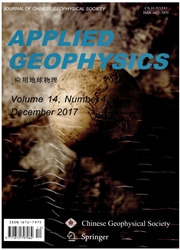

 中文摘要:
中文摘要:
通常首波被认为是以下层高速度沿着平坦界面传播的折射波。然而,沿着不规则界面首波的传播路径至今仍不明确。在这里,我们将利用重叠单元(SEMO)方法以模拟的方式来研究这个问题。之所以选择重叠单元方法,是因为这种方法可以准确地计算出沿不规则界面传播的界面波。然后我们利用时间窗将首播从界面波中分离出来,并分析首播沿不规则界面传播进程中能量的变化和走时的变化。分析结果表明,与平坦的界面上首播的传播情况不同,沿不规则界面传播的首播由两种机制产生:折射机制和透射机制,也就是说,首播可能是沿界面传播的折射波或高速介质中向低速介质的透射波。关于首播的这种认识将有助于我们建设更加精确的首播反演方法,例如建立更为精确的首波旅行时层析成像,并由此获得更准确的地下结构模型,这对于研究认识一些特殊地区(如青藏高原)的形成机制是非常重要的。
 英文摘要:
英文摘要:
Head waves are usually considered to be the refracted waves propagating along flat interfaces with an underlying higher velocity.However,the path that the rays travel along in media with irregular interfaces is not clear.Here we study the problem by simulation using a new approach of the spectral-element method with some overlapped elements(SEMO) that can accurately evaluate waves traveling along an irregular interface.Consequently,the head waves are separated from interface waves by a time window.Thus,their energy and arrival time changes can be analyzed independently.These analyses demonstrate that,contrary to the case for head waves propagating along a flat interface,there are two mechanisms for head waves traveling along an irregular interface:a refraction mechanism and transmission mechanism.That is,the head waves may be refracted waves propagating along the interface or transmitted waves induced by the waves propagating in the higher-velocity media.Such knowledge will be helpful in constructing a more accurate inversion method,such as head wave travel-time tomography,and in obtaining a more accurate model of subsurface structure which is very important for understanding the formation mechanism of some special areas,such as the Tibetan Plateau.
 同期刊论文项目
同期刊论文项目
 同项目期刊论文
同项目期刊论文
 A New Technique to Synthesize Seismography with More Flexibility: the Legendre Spectral Element Meth
A New Technique to Synthesize Seismography with More Flexibility: the Legendre Spectral Element Meth Kinematic rupture model and hypocenter relocation of the 2013 Mw6.6 Lushan Earthquake constrained by
Kinematic rupture model and hypocenter relocation of the 2013 Mw6.6 Lushan Earthquake constrained by Study on the selecting principle of test soil samples in nonlinear seismic response analysis of stra
Study on the selecting principle of test soil samples in nonlinear seismic response analysis of stra Preliminary research on the method for determination of ground motion parameters of diffuse earthqua
Preliminary research on the method for determination of ground motion parameters of diffuse earthqua Localized Boundary Integral Equation–Discrete Wavenumber Method for Simulating Wave Propagation in I
Localized Boundary Integral Equation–Discrete Wavenumber Method for Simulating Wave Propagation in I 期刊信息
期刊信息
